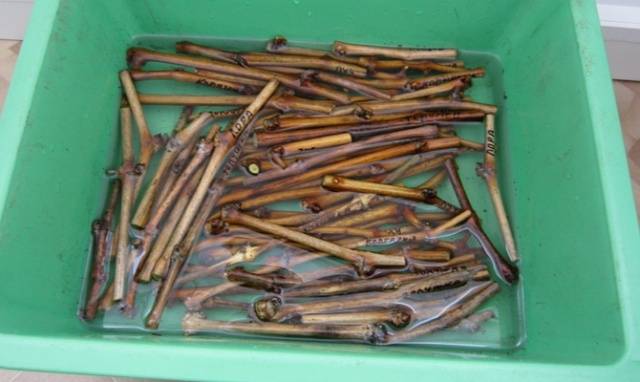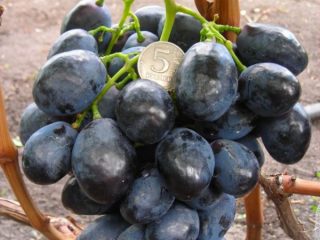Content
Laura grapes are distinguished by their unpretentiousness, excellent taste and excellent presentation, combining the best characteristics of Western and Eastern grape varieties. This table variety has long been popular among winegrowers - for three years it was one of the five most productive and tasty.
The Laura grape is included in the register of varieties under the name Flora, but among gardeners it is known as Laura.
Characteristics of the variety
Laura grapes were cultivated by crossing different grape varieties and retained their best qualities. A detailed description of the variety characterizes it:
- early ripening - no more than 120 days;
- high sugar content and low acidity - their balance gives a unique taste with a light nutmeg aroma;
- the formation of beautiful conical clusters of equal size and weight;
- large light berries with a waxy coating.
Grape bushes
Strong grape bushes of the Laura variety of medium height grow very quickly and bear fruit already in the second or third year after planting. The bushes have a female flowering pattern and require hand pollination.The leaves are palmate-lobed, edged with small teeth; the photo shows a grape bush of the Laura variety.
Too many fruitful shoots are formed on the bushes, which can put too much load on it, so you should leave no more than 50. With optimal load on the bush, it produces large brushes up to 40 cm long and weighing up to 1 kg and holds them until frost. During the ripening period of grapes, you need to pick off those leaves that shade the bunches.
If there are too few clusters on a grape bush, their size increases and ripening time is reduced. The consequence may be the re-emergence of shoots before wintering and depletion of the vineyard, which will lead to its death.
Berries
Crispy, juicy berries with thin skin are oval in shape and weigh 8-10 g. Thanks to their strong attachment to the stalk, they do not fall off when harvesting grapes. The color of the berries is light green, amber on the sunny side.
Sugar content reaches 20%. Due to its high sugar accumulation, the Laura grape variety is used to make sweet dessert wine. The fruits have good shelf life after being picked from the bush and tolerate transportation excellently. The density of berries on the bunches is average.
Description of the variety can be seen in the video:
Resistance
The Laura grape variety is unpretentious to growing conditions and has good winter hardiness, withstanding sub-zero temperatures down to 23-26 degrees. If the rules of care are followed, it ripens well in all regions and is characterized by high resistance to many common pathologies, such as gray and white rot.
Flaws
The Laura variety also has certain disadvantages:
- worsening weather conditions lead to a decrease in its taste;
- too thin skin attracts wasps, grape yields are not stable each year;
- if the bushes are formed incorrectly, the size of the berries decreases and their sugar content decreases;
- the Laura variety does not have immunity to some fungal diseases;
- Excessive loading of the bush with bunches lengthens the ripening period and depletes the vine.
Reproduction
Any propagation options are comfortable for Laura grapes: cuttings or seedlings.
Growing a seedling
You can grow a seedling of the Laura variety in different ways.
- Bend the vine shoot next to the bush and plant it in the soil to a depth of 20 cm. When young grape roots appear, cut the bush and replant.
- Prepare a plastic bag with peat. Tie it to a vine shoot, placing the base of the shoot there. After the root system has formed, cut off the shoot and replant.
- When pruning Laura grapes, you need to choose healthier shoots. Prepare a container with peat or fertile soil and plant shoots in it for the winter. During this time, it will develop roots, and in the spring the grape seedling can be transplanted to the site.
Cuttings
Signs of aging of a grape bush are manifested in a decrease in yield and a decrease in the number of eyes on the shoot. The berries become small. But although the grape vine is aging, its powerful root system is capable of providing the bush with nutrition for a long time. Therefore, the vine is updated using cuttings:
- when pruning, select several shoots and place them in a cool place;
- then the grape cuttings are brought into a warm room and kept for several hours at room temperature;
- Next, the cuttings are immersed in warm water, where they remain for about an hour;
- the end of the cutting is cut at an angle at a distance of 1 cm from the lower eye;
- before the grafting procedure itself, the grape cutting is dipped into the Humate nutrient solution and carefully inserted into the previously split and extended trunk with a pointed end - one cutting on each side;
- the place where the trunk splits must be wrapped with a cotton flap;
- the joints should be lubricated with garden varnish;
- during autumn grafting, the trunk is sprinkled with earth, and the cutting is covered with sawdust and soil.
Planting Laura grapes
Proper planting of grape bushes ensures sustainable development and high productivity of the plant.
In the video you can see the rules for planting grapes:
Site selection
To grow Laura grapes, you need to choose the right place and soil:
- the site should be located on a hill so that groundwater does not come close to it;
- if grape bushes are planted on a slope, it should be on the south side;
- Any soil except heavy soil is suitable for planting grape bushes;
- the bushes should receive enough sunlight and heat;
- As a natural protection for grapes from wind and cold, you can use the walls of outbuildings or the dense crown of trees growing nearby.
Planting seedlings
To plant grape seedlings, you should prepare holes in advance at a distance of one and a half meters from each other. You need to step back half a meter from the wall. A gap of 2 m is left between the rows of bushes. The depth of the holes should be 2 times the height of the roots.Fertilizers are placed in the holes and watered for 15 days so that the soil is saturated with minerals.
Laura grape seedlings are placed in water the day before planting. After a day, their roots are lightly trimmed, leaving the strongest ones. Next, they begin planting: the seedling is lowered into the hole at an angle, the roots are carefully straightened and sprinkled with earth. Compact the soil around the shoot well and water it.
Care
The rules for caring for Laura grapes are quite simple. It is necessary to organize regular watering and timely pruning vineyard No pruning is done in the first year.
Organization of watering
For regular watering, holes are dug around the bushes for drainage at a distance of up to 50 cm. Watering should be regular, but in damp and cool weather it should be stopped. If the heat sets in, increase the frequency of watering the bushes.
In spring and autumn, the soil under the seedlings must be mulched to retain moisture, and removed in the summer. Humus cannot be used as mulch, as mole crickets or pathogenic microorganisms live in it. Regular feeding of grape bushes with nitrogen, potassium and phosphorus compounds is also necessary.
Diseases and pests
Despite the resistance of Laura grapes to many fungal diseases, oidium causes a lot of trouble for winegrowers. Large plantations are treated with chemicals against this disease, and home plantings are sprayed with solutions of potassium permanganate and sulfur.
Black rot hides in the soil. Bushes of the Laura variety are protected from it by treating them with fungicides before wintering.
Pruning and shelter for the winter
Grapes Laura takes shelter for the winter, if winter temperatures in the region fall below 15 degrees.Preparation for winter includes moderate pruning, which removes any damaged or diseased branches. The standard is coated with thick lime mortar. The grape vine bends down to the ground and is secured in it with metal hooks. The top is sprinkled with soil 25-30 cm thick. Mature bushes can additionally be covered with straw or sawdust.
Reviews
The high resistance of the Laura variety is evidenced by rave reviews.
Conclusion
Laura grapes have occupied a leading position among many other varieties for many years. With proper care, it will delight you with its beautiful appearance and unique taste for a long time.























